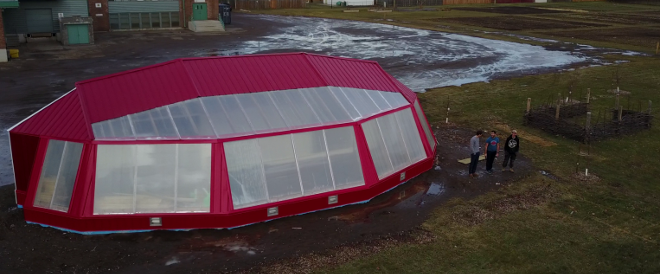Andreas Zailo and Slim Babay are addressing the food security issues facing residents in Northern Ontario with science and engineering. Their innovative greenhouse systems aim to help communities grow their own food, reducing costs, improving nutrition, and creating a sense of independence for residents.
“We basically have realized that there’s a huge issue with Northern health, affordability and also job creation,” said Zailo, one part of the duo that founded Thunder Bay-based ASM Innovations.
“Up north, people pay two to three times the price for food, and when I say ‘up north,’ I mean, you could be as close as Sioux Lookout to Thunder Bay.”
ASM’s first greenhouse was constructed in Thunder Bay in partnership with Roots to Harvest, a non-profit organization that trains young people how to grow their own food, offering them employment and experiential education opportunities.
The 900-square-foot greenhouse is situated on 97,000 square feet of land and functions 10 months of the year.
“The idea is you can start seedlings or plants earlier in the spring, shelter them through coldest parts of March and April, and then put them outside, and the greenhouse would keep producing more seedlings,” Zailo said.
"That way you can take a small year-round greenhouse and you can turn it into a big outdoor growing program.
Starting with a shipping container, the greenhouse was built using glazed panels set at various geometric angles configured to take advantage of the shifting sunlight throughout the day. It’s also designed to work with solar thermal panels and a rainwater collection system, and has LED growing lights installed so that, in the winter, when the days are shorter, the growing day can be extended by a few hours.
A complementary software system controls the greenhouse, issuing warnings if the temperature drops or if it’s low on water, and more.
Initially, the partners were aiming for a model that used high-end technologies and growing systems to allow for year-round growing. But that escalated the costs of construction, and they quickly realized it wasn’t economically or practically feasible for a lot of the communities they were trying to help.
It’s a lot easier to teach people to grow in soil first before introducing more complicated growing methods like hydroponics, Zailo reasoned.
“We got to build a greenhouse that was great from an engineering standpoint and from an optimization and unique standpoint, and of course we would do it again, but now we really need to focus on taking all the stuff we learned and making it as cheap as possible,” he said.
“Otherwise, we won't get widespread adoption, and that's a problem for us.”
So the newer models will be scaled down in simplicity and have a friendlier price point. Zailo estimates that, for about $50,000, ASM can build a basic greenhouse that is manually run by a trained operator from the community and that can function about 10 months of the year.
He figures the 900-square-foot model can annually produce about 20,000 heads of lettuce. If that lettuce is sold at $1.50 per head, the community could generate $30,000 a year. That could be a welcome new source of income for many Indigenous communities, where more than 80 per cent of residents are living below the poverty line.
There could also be opportunities to experiment with cash crops like strawberries, tomatoes, or cucumbers, which would generate more profit. Communities could also use the greenhouse to grow traditional medicines like sage and tobacco.
“The other part is that we hope people in the community would want to learn to grow as well, and by having a greenhouse operator who’s trained and who’s competent, that person becomes a knowledge centre for the community,” Zailo said.
ASM is currently in talks with a couple of communities that are looking at building greenhouses next year, as well as a farmer who’s planning to go into production full time.
But greenhouse design and construction is a passion project for Zailo and Babay, who both work full-time jobs and can spend an additional 40 hours a week running ASM Innovations as a side project.
If their designs take off and demand increases, Zailo said he could eventually see the company becoming a full-time venture. But the primary focus, Zailo said, will always be putting the communities and their needs first.
“We didn't get into it for the money,” he said. “If I had a choice between selling five at a profit or selling 100 at cost, I would sell 100 at cost.”




